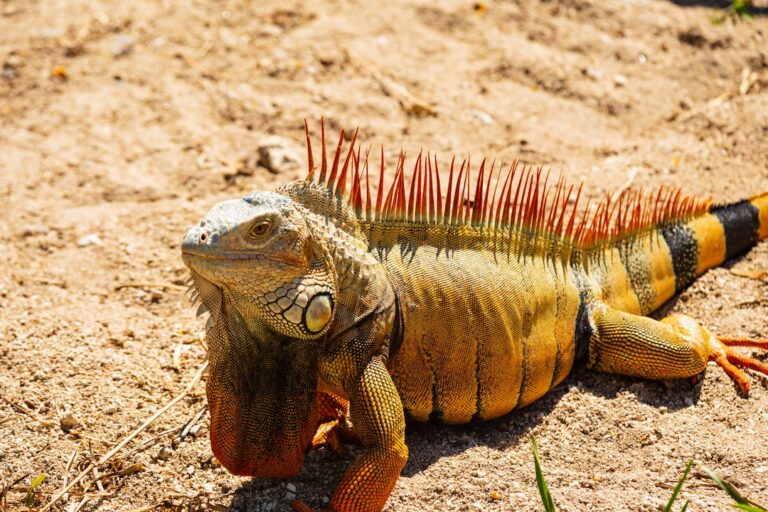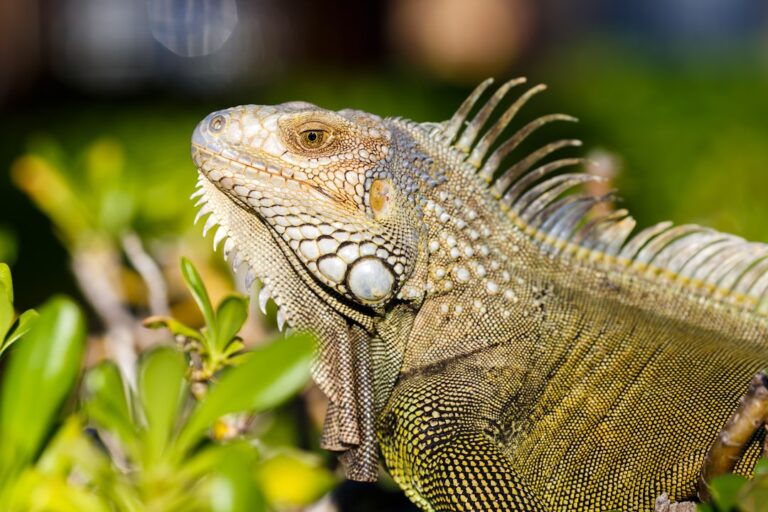Do Iguanas Bleed?
Understanding the anatomy of iguanas is crucial for their overall health and well-being. Iguanas are unique reptiles that require specific care and attention to ensure they stay healthy. One common health issue that iguanas may face is bleeding. Bleeding in iguanas can be caused by a variety of factors, including injuries, infections, and diseases. It is important for iguana owners to be aware of the signs and symptoms of bleeding and know how to properly treat it. In this article, we will explore the anatomy of iguanas, common causes of bleeding, signs and symptoms to look out for, treatment options, when to seek veterinary care, prevention techniques, and essential items for an iguana first aid kit.
Table of Contents
Understanding the Anatomy of Iguanas
To understand how bleeding can occur in iguanas, it is important to have a basic understanding of their anatomy. Iguanas have a complex circulatory system that consists of a heart, blood vessels, and blood. The heart pumps oxygenated blood from the lungs to the rest of the body through arteries. Deoxygenated blood then returns to the heart through veins to be reoxygenated in the lungs.
Common areas where bleeding may occur in iguanas include the mouth, nose, eyes, ears, cloaca (vent), and limbs. These areas are susceptible to injuries or infections that can lead to bleeding. Additionally, internal bleeding can occur if there is trauma to organs or blood vessels.
Common Causes of Iguana Bleeding
There are several common causes of bleeding in iguanas. One of the most common causes is injuries. Iguanas are active reptiles that may accidentally injure themselves while exploring their environment or during interactions with other animals or humans. Common injuries that can lead to bleeding include cuts, scrapes, puncture wounds, and broken bones.
Infections can also cause bleeding in iguanas. Bacterial, fungal, or viral infections can affect various parts of the body, including the mouth, respiratory system, and reproductive system. These infections can cause inflammation and tissue damage, leading to bleeding.
Certain diseases can also result in bleeding in iguanas. For example, metabolic bone disease is a common condition in captive iguanas that can weaken their bones and make them more prone to fractures. Fractures can cause internal bleeding or bleeding from the skin.
Signs and Symptoms of Iguana Bleeding
It is important for iguana owners to be able to recognize the signs and symptoms of bleeding in their pets. Changes in behavior may indicate that an iguana is experiencing bleeding. They may become lethargic, lose their appetite, or show signs of pain or discomfort.
Physical symptoms of bleeding can vary depending on the location and severity of the bleeding. Visible bleeding from the mouth, nose, eyes, ears, cloaca, or limbs is an obvious sign of a problem. Other physical symptoms may include swelling, bruising, or a change in coloration around the affected area.
How to Treat Minor Iguana Bleeding at Home
If an iguana experiences minor bleeding, there are steps that can be taken at home to treat the issue. The first step is to clean the wound with a mild antiseptic solution to prevent infection. It is important to be gentle and avoid causing further injury or distress to the iguana.
Applying pressure to the wound can help stop the bleeding. This can be done by using a clean cloth or gauze pad and applying firm but gentle pressure for several minutes. If the bleeding does not stop after 10-15 minutes of continuous pressure, it is important to seek veterinary care.
Natural remedies such as aloe vera gel or honey can also be applied to the wound to promote healing and prevent infection. These remedies have antimicrobial properties and can help soothe the affected area.
When to Seek Veterinary Care for Iguana Bleeding
While minor bleeding can often be treated at home, there are situations where it is necessary to seek veterinary care. Severe bleeding that does not stop with applied pressure or bleeding from internal organs should be considered an emergency and immediate veterinary attention should be sought.
Signs of infection, such as pus or a foul odor coming from the wound, should also prompt a visit to the veterinarian. Infections can quickly spread and cause further complications if left untreated.
Underlying health issues may also require veterinary care. If an iguana has a pre-existing condition or is showing signs of illness in addition to bleeding, it is important to consult with a veterinarian for a proper diagnosis and treatment plan.
Preventing Iguana Injuries and Bleeding
Prevention is key when it comes to keeping iguanas healthy and free from injuries and bleeding. Proper handling techniques are essential to avoid causing harm to the iguana. It is important to support their body properly and avoid squeezing or dropping them.
Providing a safe environment for iguanas is also crucial. This includes ensuring that their enclosure is secure and free from hazards that could cause injury. Regular health check-ups with a veterinarian can help identify any potential health issues early on and prevent them from progressing into more serious conditions.
The Importance of Proper Handling Techniques for Iguanas
Proper handling techniques are not only important for preventing injuries, but they also play a role in maintaining the overall health and well-being of iguanas. Improper handling can cause stress, which can weaken their immune system and make them more susceptible to infections and diseases.
When handling an iguana, it is important to support their body properly. This means using both hands to hold them and avoiding squeezing or putting pressure on their abdomen. It is also important to avoid grabbing or pulling on their tail, as this can cause injury.
Common Iguana Health Issues and Bleeding
There are several common health issues that iguanas may face that can lead to bleeding. Metabolic bone disease is a condition that occurs when an iguana’s diet lacks the proper nutrients needed for healthy bone development. This can result in weak bones that are more prone to fractures, which can cause bleeding.
Respiratory infections are another common health issue in iguanas. These infections can cause inflammation and damage to the respiratory system, leading to bleeding from the nose or mouth. Parasites, such as mites or ticks, can also cause irritation and damage to the skin, resulting in bleeding.
Iguana First Aid Kit Essentials for Bleeding Emergencies
Having a well-stocked first aid kit specifically for iguanas is essential for handling bleeding emergencies. Some essential items to include in an iguana first aid kit for bleeding emergencies include gauze pads or strips, antiseptic solution or wipes, styptic powder or gel, and a clean cloth or towel.
Gauze pads or strips can be used to apply pressure to a bleeding wound and help stop the bleeding. Antiseptic solution or wipes should be used to clean the wound before applying any other treatments. Styptic powder or gel can be applied to minor cuts or wounds to help stop bleeding.
A clean cloth or towel should be included in the first aid kit to handle the iguana safely and prevent further injury during treatment.
Maintaining a Healthy Environment for Iguanas to Prevent Bleeding
Maintaining a healthy environment for iguanas is crucial for preventing injuries and bleeding. Proper lighting, temperature, and humidity levels are important for their overall health and well-being. Iguanas require UVB lighting to properly metabolize calcium and prevent metabolic bone disease.
The temperature in their enclosure should be kept within a specific range to ensure they can properly regulate their body temperature. A basking spot should be provided where the temperature is higher, allowing the iguana to thermoregulate.
Humidity levels should also be monitored and maintained within the appropriate range for the species of iguana. This can help prevent respiratory infections and keep their skin healthy.
A balanced diet is also important for preventing health issues in iguanas. Their diet should consist of a variety of leafy greens, vegetables, and fruits to provide the necessary nutrients for their overall health and well-being.
Understanding the anatomy of iguanas and common health issues they may face, including bleeding, is crucial for their overall health and well-being. By being aware of the signs and symptoms of bleeding, knowing how to properly treat minor bleeding at home, and when to seek veterinary care, iguana owners can ensure their pets receive the necessary care and attention they need. Preventing injuries and maintaining a healthy environment for iguanas are also important factors in preventing bleeding and other health issues. By following proper handling techniques, providing a safe environment, and regular health check-ups, iguana owners can help keep their pets healthy and free from bleeding.
If you’re curious about the fascinating world of reptiles, you might be interested in an article titled “Why Do Turtles Keep Their Mouth Open?” This informative piece on Reptile Friend explores the peculiar behavior of turtles and provides insights into why they often keep their mouths open. It’s a great read for reptile enthusiasts looking to expand their knowledge. Check it out here.







